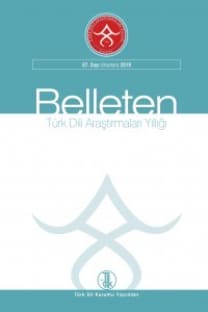(GÜNEY AZERBAYCAN) URMİYE AĞZINDA FİİLLERİN BİRLEŞİK ÇEKİMİ VE -(y)(A)rdlA(r) BİÇİMİ
İran’daki Türkçe değişkeler, Güney Azerbaycan Türkçesi, Urmiye ağzı, birleşik çekim
THE COMPOUND TENSE OF VERBS IN URMIA DIALECT (SOUTH AZERBAIJANI) AND THE FORM OF -(y)(A)rdlA(r)
Turkic varieties in Iran, South Azerbaijani, Urmia dialect, compound tense,
___
- Apaydın, T. (1966). Toprağa basınca. İstanbul: Arkın. (=TB)
- Ayverdi, S. (2007). Ne idik ne olduk. İstanbul: Kubbealtı. (=NİNO)
- Banarlı, N.S. (2007). Edebiyat sohbetleri. İstanbul: Kubbealtı. (=ES)
- Emiroğlu, Ö. (2001). Hisar’da kültür ve sanat konuşmaları. Ankara: Kültür Bakanlığı.(=HKSK)
- Tamer, R. (1988). Pazar kahvesi. Birkaç resim, birkaç isim. İstanbul: Toker. (=PK)
- ISSN: 0564-5050
- Yayın Aralığı: 2
- Başlangıç: 1953
- Yayıncı: Türk Dil Kurumu
TÜRKÇE İLK KUR’AN TERCÜMELERİNDEN MEŞHED NÜSHASININ (293 No.) TÜRK DİLİ TARİHİNDEKİ YERİ VE ÖNEMİ
(GÜNEY AZERBAYCAN) URMİYE AĞZINDA FİİLLERİN BİRLEŞİK ÇEKİMİ VE -(y)(A)rdlA(r) BİÇİMİ
ÇİNÇAVAT KELİMESİNİN ETİMOLOJİSİ
VATİKAN KÜTÜPHANESİNDE TÜRKÇE BİR TIP METNİ: ECZĀ-YI LOKMĀN ḤEKĪM
YENİSEY YAZITLARINDA GEÇEN adrıl- seçlin- İKİLEMESİ ÜZERİNE
YENİSEY VE ALTAY KIRGIZLARINDA SİYASİ UNVAN OLARAK ACO VE İDİ TERİMLERİNİN MENŞESİ VE ANLAMI
EŞ-ŞİFÂ’NIN TÜRKÇE TERCÜMELERİ VE TÂLİB HOCAZÂDE İSHÂK NECÎB KARSÎ’NİN TERCEME-İ ŞİFÂ-İ ŞERÎF’İ
